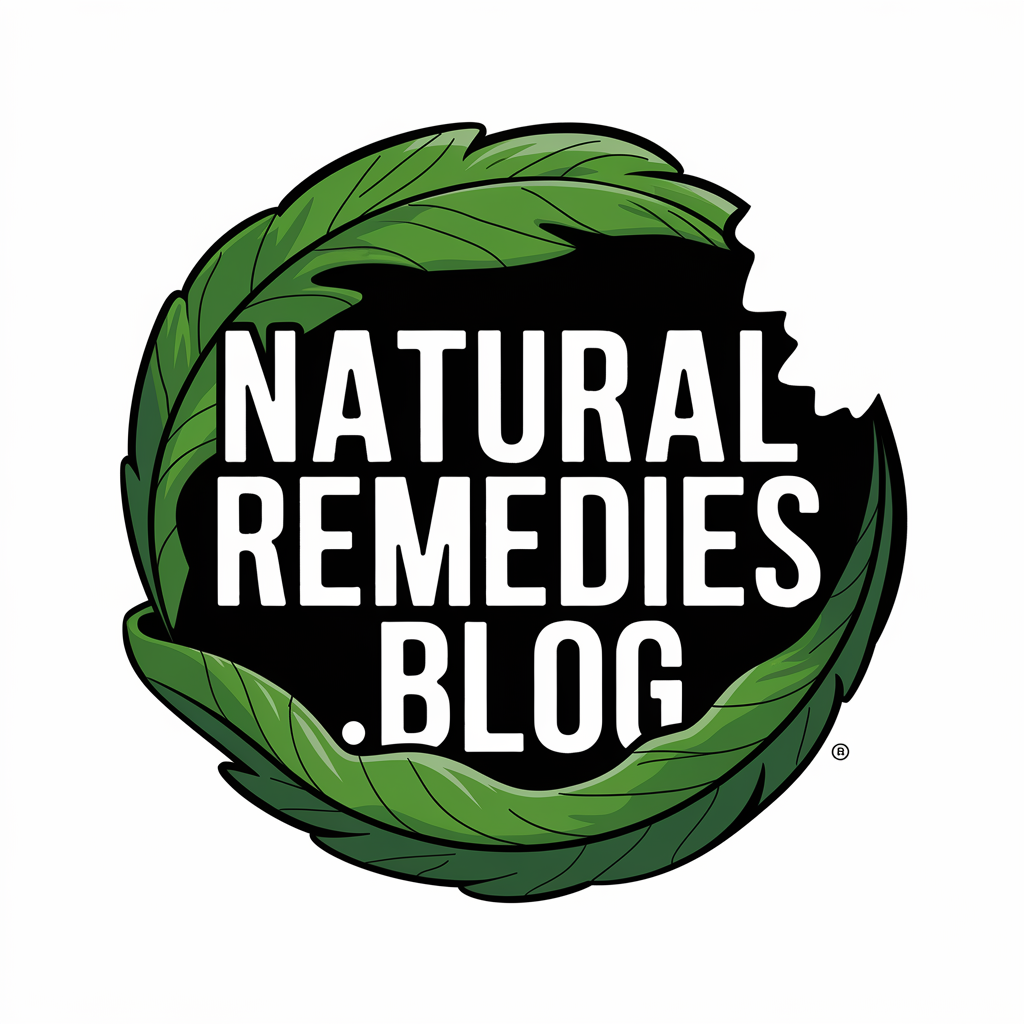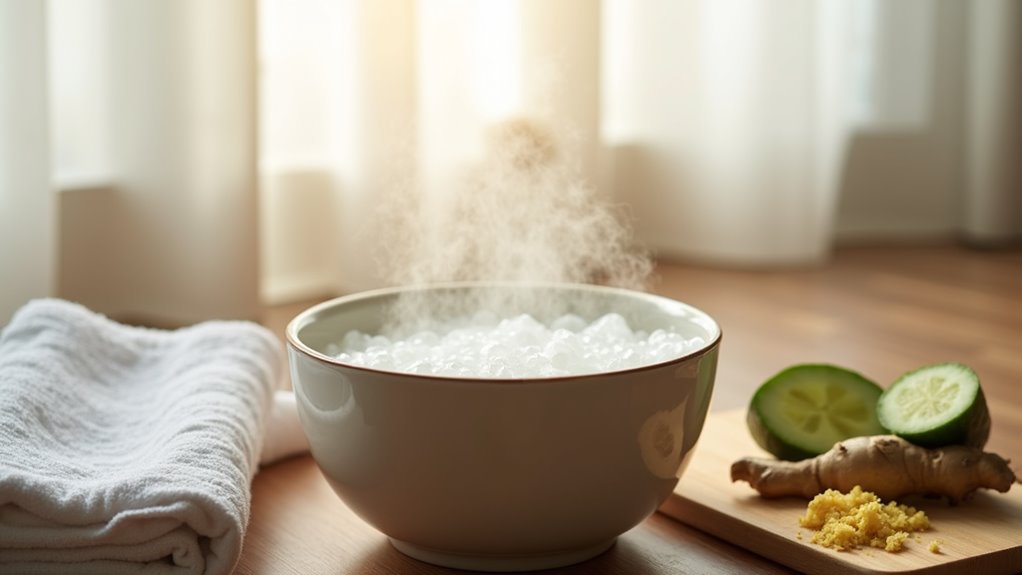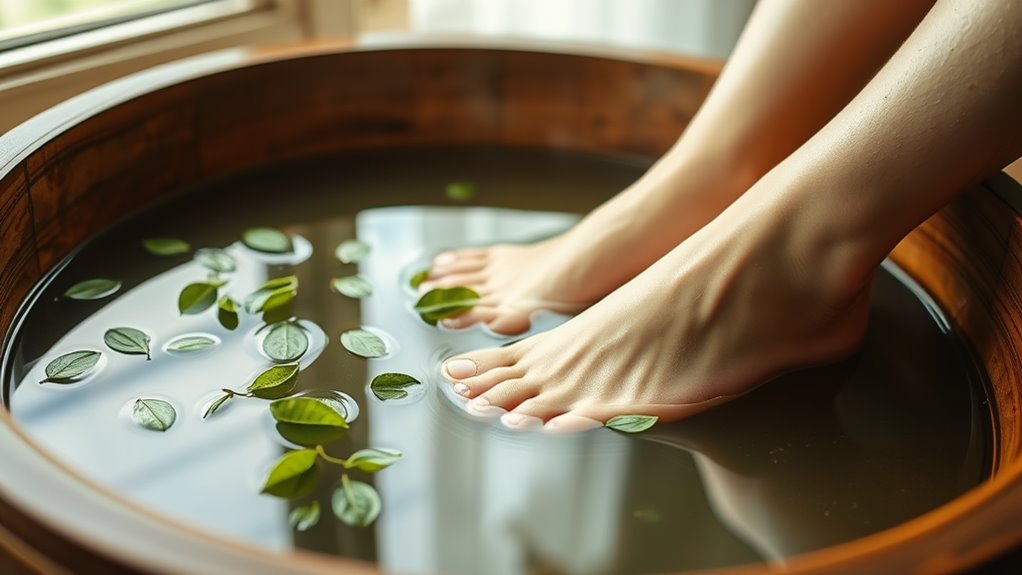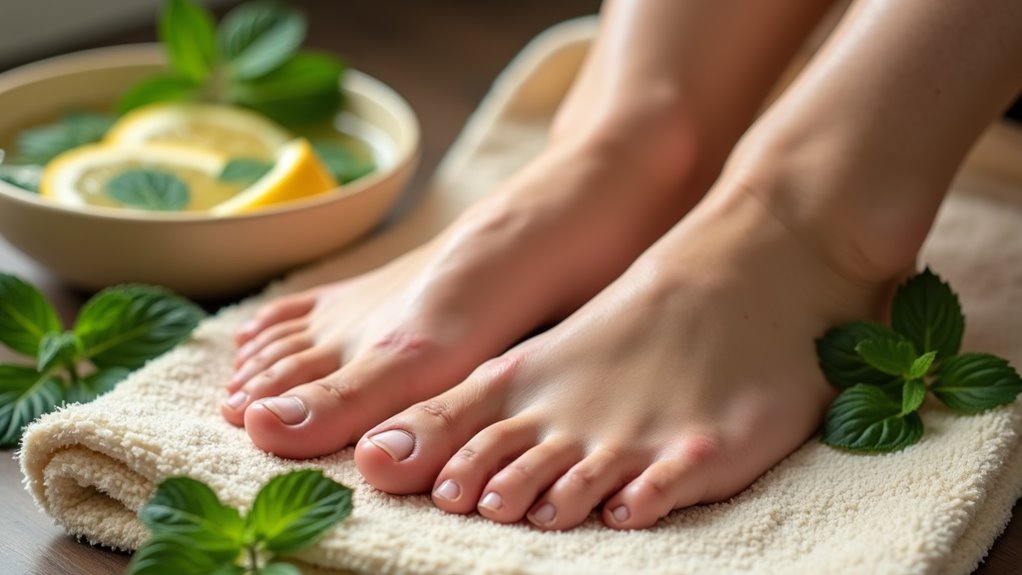Home Remedies That Helped My Swollen Ankles Feel Normal Again
You can reduce ankle swelling quickly through proven home remedies that improve circulation and decrease fluid retention. Start by elevating your legs above heart level for 20 minutes, three times daily. Combine this with compression socks, reduced sodium intake, and regular ankle exercises like rotations and flexions. Cold therapy helps initial inflammation, while warm compresses improve blood flow later. These evidence-based solutions offer just the beginning of your path to normalized ankles.
Why My Ankles Started Swelling
When your ankles swell, it’s often due to fluid retention in the lower extremities, a condition medically known as peripheral edema.
While seeking swollen feet remedies, it’s crucial to understand the underlying causes. Common triggers include prolonged sitting or standing, pregnancy, excessive sodium intake, or medications like calcium channel blockers.
More serious causes might involve heart, kidney, or liver problems. Being overweight, having high blood pressure, or experiencing hormonal changes can also contribute to ankle swelling.
Understanding these root causes helps you choose appropriate treatment strategies and determine when medical attention becomes necessary.
Hot weather conditions can make swelling worse because your veins naturally expand in response to heat.
Simple Elevation Techniques That Worked
Three proven elevation techniques can effectively reduce ankle swelling by promoting fluid drainage back toward the heart.
When you elevate your legs, gravity assists in moving excess fluid away from your ankles, reducing inflammation and discomfort.
- Prop your legs above heart level using pillows while lying flat on your back for 20 minutes, 3-4 times daily
- Rest your legs up against a wall while lying on the floor, maintaining a 90-degree angle for 10-15 minutes
- Use an adjustable footstool under your desk while seated, keeping ankles at least 6-8 inches above floor level
Salt Reduction and Dietary Changes
Since excessive sodium intake can worsen fluid retention, managing your salt consumption plays a crucial role in reducing ankle swelling.
You’ll want to limit your daily sodium intake to 2,300mg or less. Replace processed foods with fresh fruits, vegetables, and lean proteins.
Include potassium-rich foods like bananas, sweet potatoes, and leafy greens to help balance your body’s fluid levels. Foods high in magnesium, such as nuts and whole grains, can also help reduce swelling.
Don’t forget to stay hydrated with water while avoiding alcohol and caffeine, as these can contribute to fluid retention.
Consider adding elderberry supplements to your diet, as they can help boost your immune system and reduce inflammation in the body.
Essential Oils and Massage Methods
Essential oils can provide significant relief for swollen ankles when combined with proper massage techniques.
Peppermint oil’s cooling properties help to reduce inflammation and improve circulation. You’ll find that lavender oil not only soothes discomfort but also promotes relaxation of the ankle muscles when gently massaged in circular motions.
For maximum effectiveness, you can create a natural blend by mixing 2-3 drops each of peppermint and lavender oils with a carrier oil like coconut or jojoba. Then apply the mixture using firm but gentle upward strokes.
Adding cypress oil to your blend provides additional circulation-boosting benefits for faster relief.
Peppermint Oil Relief Techniques
Peppermint oil offers therapeutic relief for swollen ankles through its natural anti-inflammatory and cooling properties. When applied correctly, it helps reduce swelling while improving circulation to the affected area.
To use peppermint oil effectively:
- Dilute 3-5 drops of peppermint oil with 1 tablespoon of carrier oil like coconut or jojoba.
- Massage the mixture into your swollen ankles using gentle, upward strokes for 5-10 minutes.
- Apply this treatment 2-3 times daily, especially before bed and after long periods of standing.
Always perform a patch test first to ensure you don’t have any skin sensitivity to the oil.
Lavender Massage Benefits
Lavender essential oil provides powerful anti-inflammatory and calming benefits when used in therapeutic massage for swollen ankles.
When you combine it with a carrier oil like coconut or jojoba, you’ll create an effective blend that reduces inflammation and improves circulation.
Apply 3-4 drops of lavender oil mixed with 1 tablespoon of carrier oil.
Using gentle upward strokes, massage the mixture from your ankles toward your heart for 5-10 minutes.
The aromatherapeutic properties will help you relax while the massage technique encourages lymphatic drainage and reduces fluid retention.
You can repeat this treatment twice daily for optimal results.
Blend Natural Oil Mixtures
A powerful combination of essential oils can provide enhanced therapeutic benefits for swollen ankles when properly blended.
You’ll need a carrier oil like sweet almond or jojoba as your base before adding therapeutic essential oils.
Mix these proven anti-inflammatory oils for optimal results:
- Combine 3 drops of peppermint oil with 2 drops of eucalyptus oil to stimulate circulation.
- Add 4 drops of lavender oil and 2 drops of chamomile oil to reduce inflammation.
- Mix in 3 drops of cypress oil to strengthen vein walls and improve lymphatic drainage.
Apply this blend using gentle, upward strokes toward your heart.
Compression Socks: My Experience
The best decision I made for managing swollen ankles was investing in compression socks. These specialized garments provide graduated pressure that helps improve circulation and reduce fluid buildup in your lower legs. Long-term lifestyle changes combined with compression therapy have helped thousands find lasting relief from swelling.
| Feature | Benefit |
|---|---|
| Graduated Compression | Promotes upward blood flow |
| Moisture-wicking | Keeps feet dry and comfortable |
| Support Zones | Targets key pressure points |
You’ll want to wear them throughout the day, especially during periods of prolonged sitting or standing. Start with a moderate compression level (15-20 mmHg) and consult your doctor before trying higher compression levels. Remember to replace them every 3-4 months to maintain optimal effectiveness.
Exercise and Movement Strategies
You can reduce ankle swelling through a consistent walking routine of 15-30 minutes daily, which promotes healthy circulation and lymphatic drainage.
Regular ankle flexion exercises, including pointing and rotating your feet while seated, help mobilize excess fluid buildup. These targeted movements, when performed 3-4 times daily, complement walking by strengthening the muscles that support proper ankle function.
Simple Walking Routines
Regular walking serves as one of the most effective exercises for reducing ankle swelling, as it promotes healthy circulation and lymphatic drainage.
You’ll want to start with a gentle 10-minute walk and gradually increase duration as your comfort level improves.
- Begin your walking routine on flat, even surfaces to minimize stress on your ankles.
- Take short breaks every 15-20 minutes to flex and rotate your ankles.
- Schedule your walks during cooler parts of the day to prevent heat-related swelling.
If you experience increased discomfort, reduce walking intensity or consult your healthcare provider for personalized guidance.
Ankle Flexion Exercises
Simple ankle flexion exercises strengthen muscles and enhance circulation around swollen joints, making them an essential component of any ankle swelling management plan. You’ll want to perform these exercises while seated with your feet elevated.
| Movement | Repetitions | Duration |
|---|---|---|
| Point toes down | 10 | 5 seconds |
| Flex toes up | 10 | 5 seconds |
| Rotate clockwise | 8 | 3 seconds |
| Rotate counter-clockwise | 8 | 3 seconds |
Perform these exercises three times daily, preferably in the morning, afternoon, and before bed. If you experience pain, reduce the intensity or consult your healthcare provider. Remember to maintain smooth, controlled movements throughout each exercise.
Natural Herbal Remedies
Several herbal remedies have demonstrated effectiveness in reducing ankle swelling through their natural anti-inflammatory properties.
Research suggests these botanicals can help improve circulation and reduce fluid retention when used consistently.
-
Ginger root contains gingerols that decrease inflammation and can be consumed as tea or applied topically as a compress.
-
Parsley’s natural diuretic properties help flush excess fluid from tissues when eaten fresh or steeped as tea.
-
Dandelion root supports kidney function and reduces water retention, available as a supplement or tea.
Prolonged sitting or standing can significantly worsen swelling, so combining herbal treatments with regular movement is essential.
Always consult your healthcare provider before starting any herbal treatment, especially if you’re taking medications.
Cold and Hot Therapy Applications
When applied correctly, alternating between cold and hot therapy can effectively reduce ankle swelling and accelerate the healing process. You’ll need to follow specific timing and temperature guidelines for optimal results.
| Cold Therapy | Hot Therapy |
|---|---|
| Ice pack 15 min | Warm compress 10 min |
| Reduces inflammation | Increases circulation |
| Apply first 24-48 hrs | Start after 48 hrs |
| 40°F (4°C) temp | 104°F (40°C) temp |
Remember to wrap ice packs in a thin towel to protect your skin, and never apply heat during the initial injury phase. You can repeat these treatments 3-4 times daily, allowing at least 30 minutes between sessions.
Sleep Position Adjustments
When you’re dealing with swollen ankles, proper sleep positioning can make a significant difference in reducing fluid accumulation overnight.
You’ll want to elevate your feet above heart level by placing one or two firm pillows under your ankles and calves while lying flat on your back.
For optimal results, position the pillows at a 15-30 degree angle, ensuring your legs are supported from ankle to knee without creating pressure points.
Elevate While You Rest
Since gravity plays a crucial role in fluid accumulation, elevating your ankles above heart level while resting can significantly reduce swelling.
The key is to maintain proper elevation throughout your rest period to maximize the benefits of this therapeutic position.
- Place 3-4 firm pillows under your legs while lying flat on your back, ensuring your ankles are positioned higher than your chest.
- Maintain this elevated position for 15-20 minutes, three times daily.
- If you’re dealing with severe swelling, try increasing elevation time to 30 minutes per session.
This technique helps promote circulation and lymphatic drainage, allowing excess fluid to move away from your ankles naturally.
Best Pillow Placement Tips
The correct pillow placement during sleep plays a vital role in managing ankle swelling and promoting healthy circulation throughout the night.
Position your body with your ankles at least 6 inches above heart level. Place two firm pillows lengthwise under your legs, starting from your ankles and extending to your knees.
If you’re a side sleeper, stack the pillows between your legs while keeping your ankles elevated. Don’t let your feet hang over the edge of the pillows, as this can restrict blood flow.
For added comfort and support, use a small rolled towel under your ankles to prevent hyperextension.
Lifestyle Changes for Long-Term Relief
Making lasting changes to your daily routine can significantly reduce ankle swelling and prevent future occurrences. Research shows that consistent lifestyle modifications can improve circulation and reduce fluid retention in your lower extremities.
-
Maintain a healthy weight through regular exercise, focusing on low-impact activities like swimming or cycling that won’t stress your joints.
-
Limit sodium intake to less than 2,300mg daily and increase consumption of potassium-rich foods.
-
Choose loose-fitting clothing and avoid sitting or standing for extended periods; take regular movement breaks every hour.
These evidence-based changes, when implemented consistently, can provide long-term relief from ankle swelling.
Consider incorporating gentle movement classes like yoga or tai chi to improve flexibility and promote better circulation throughout the body.






